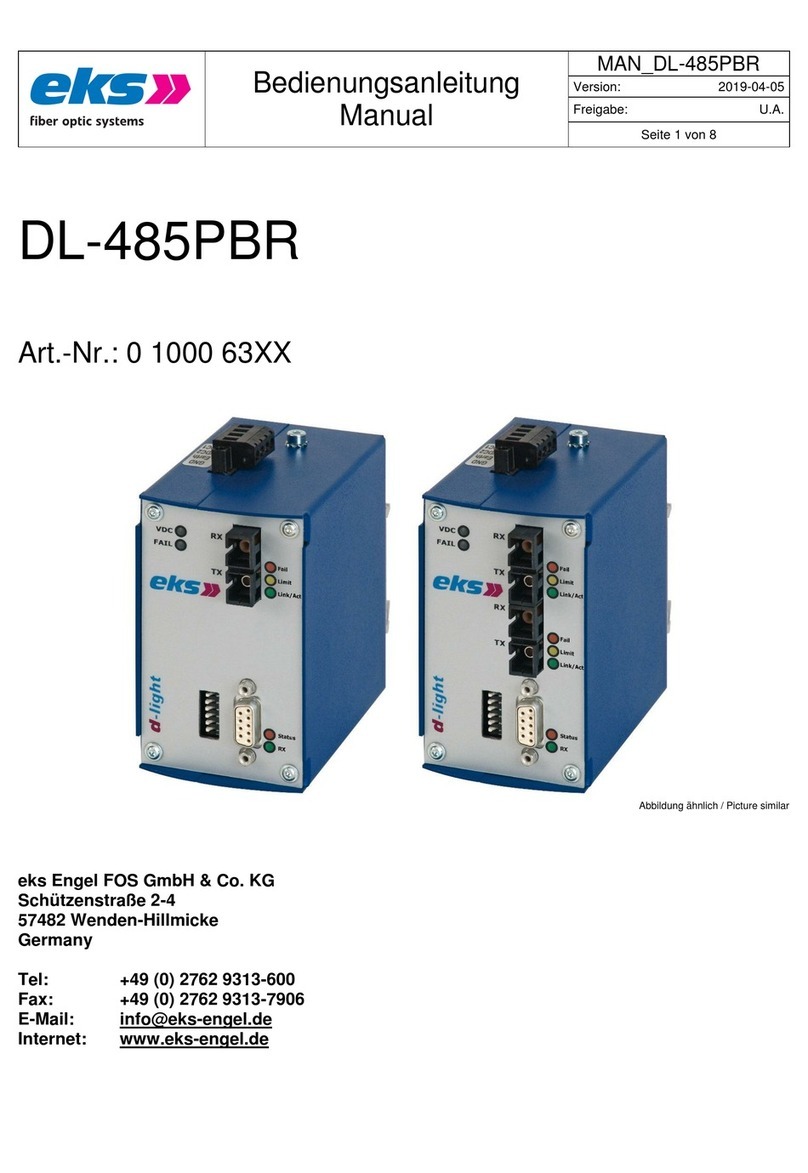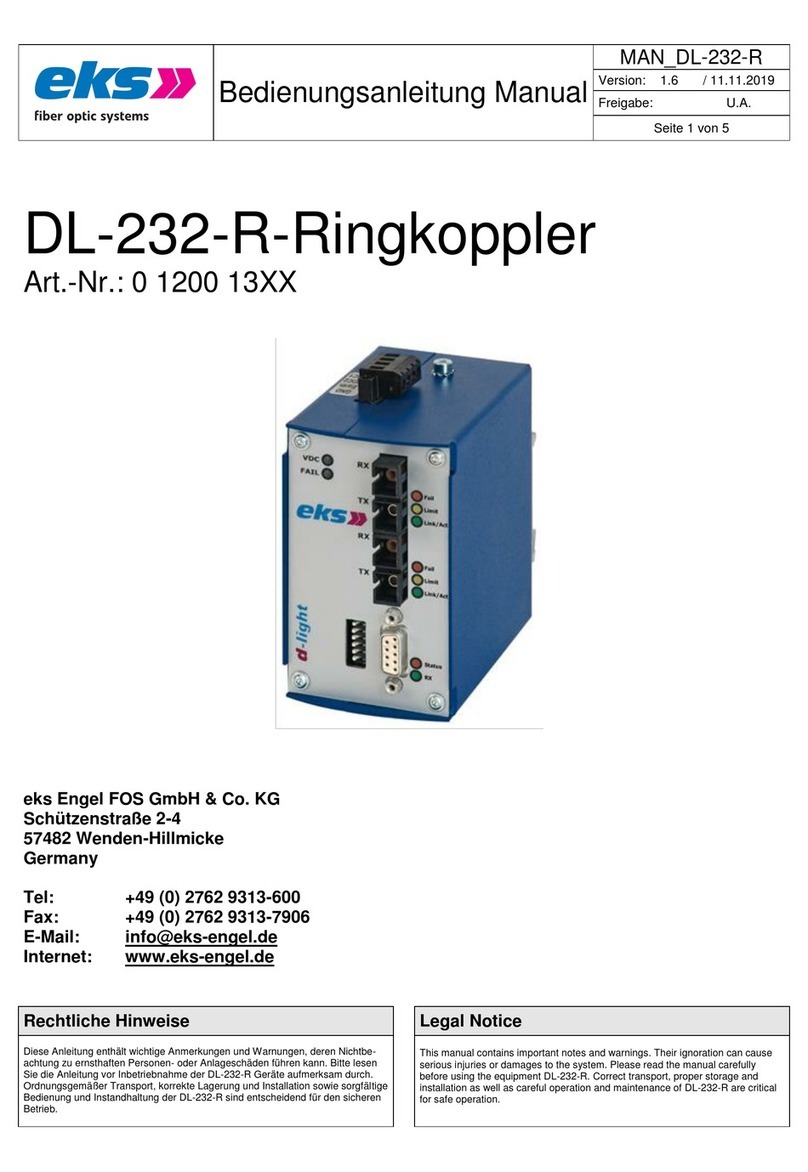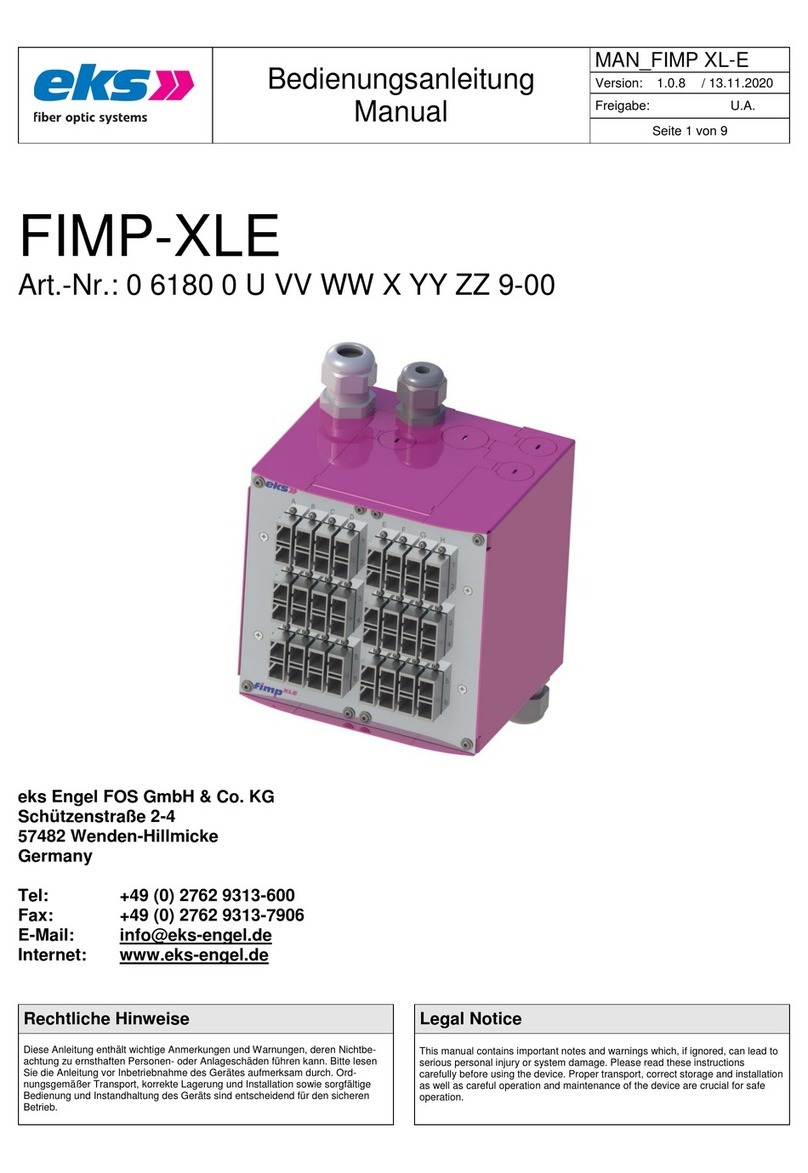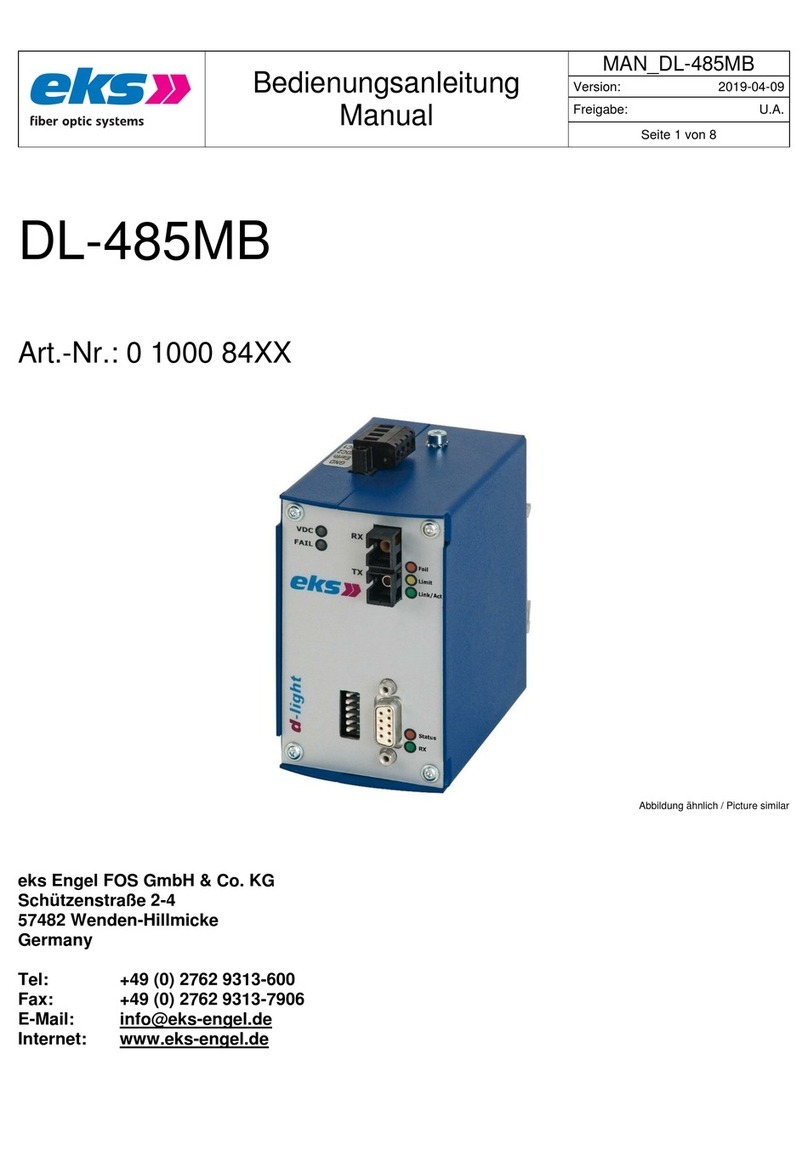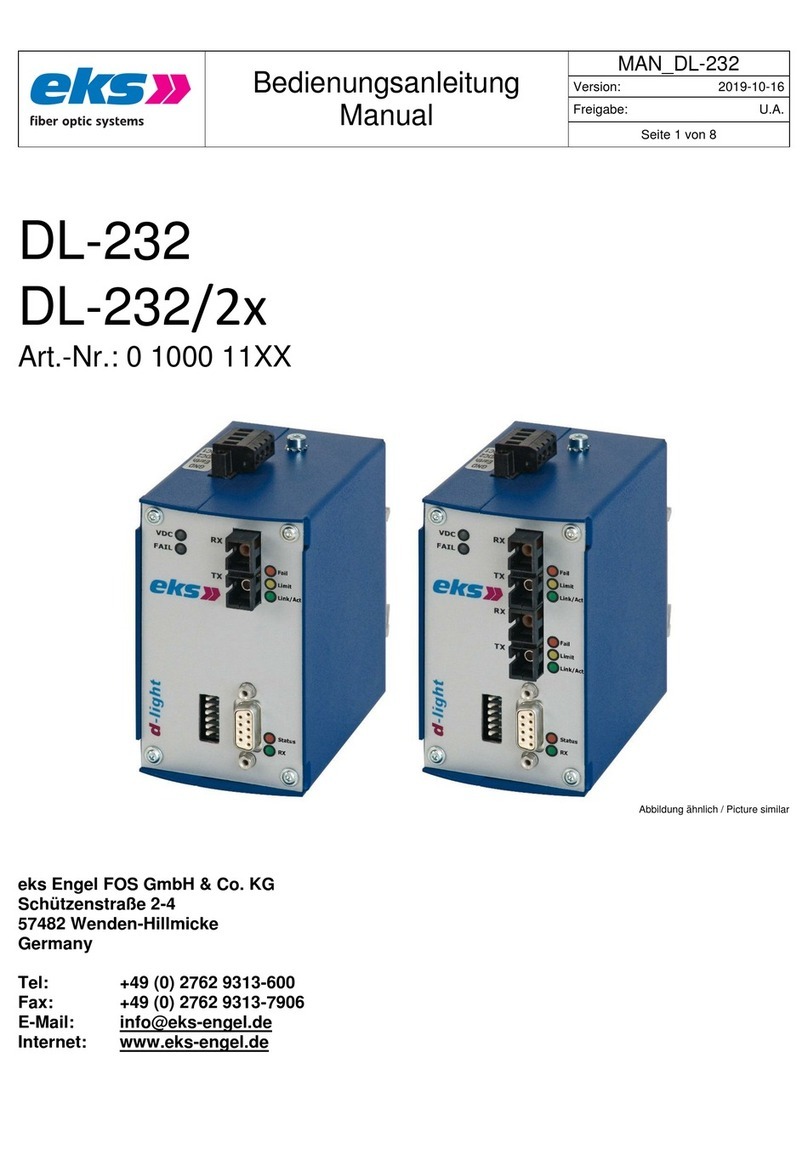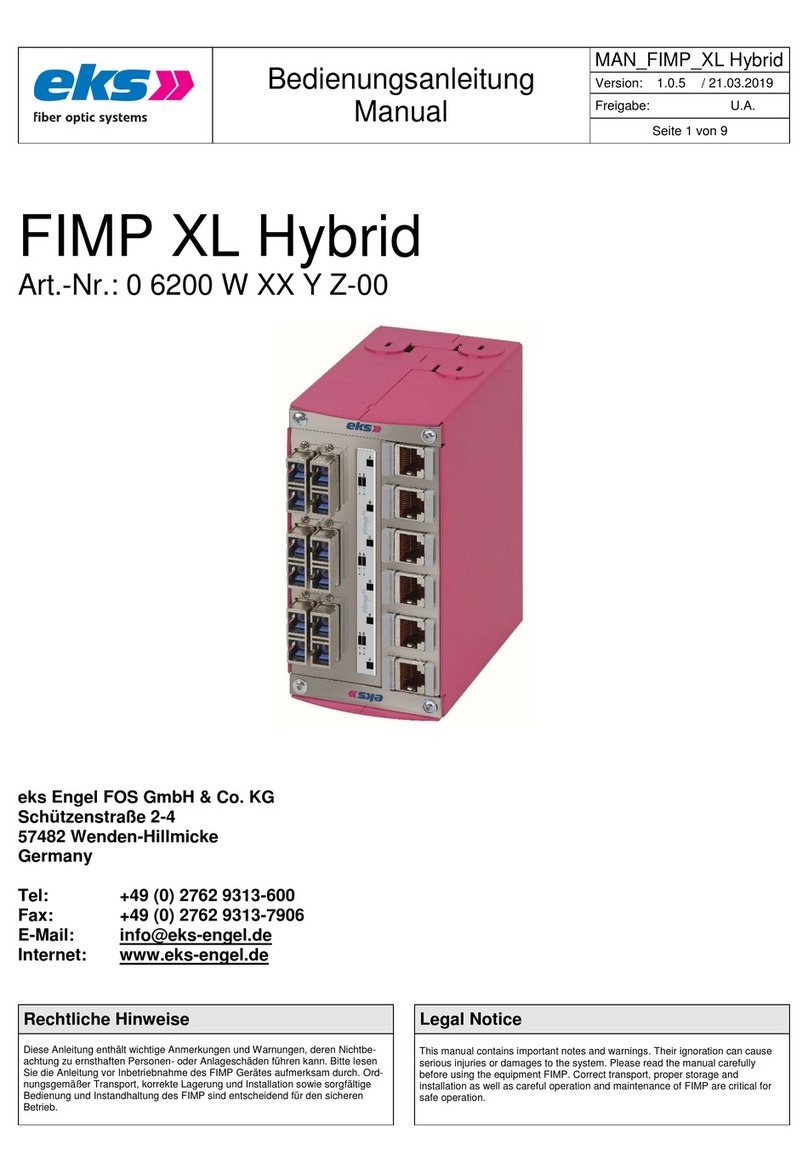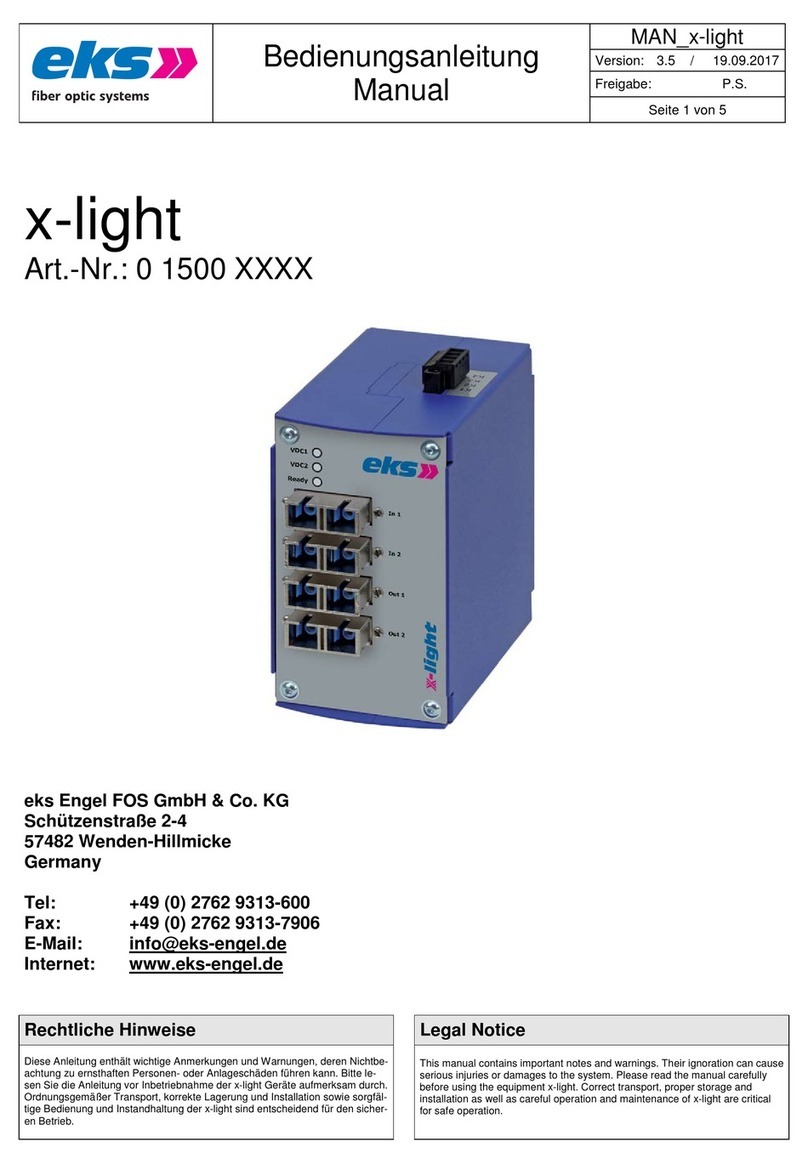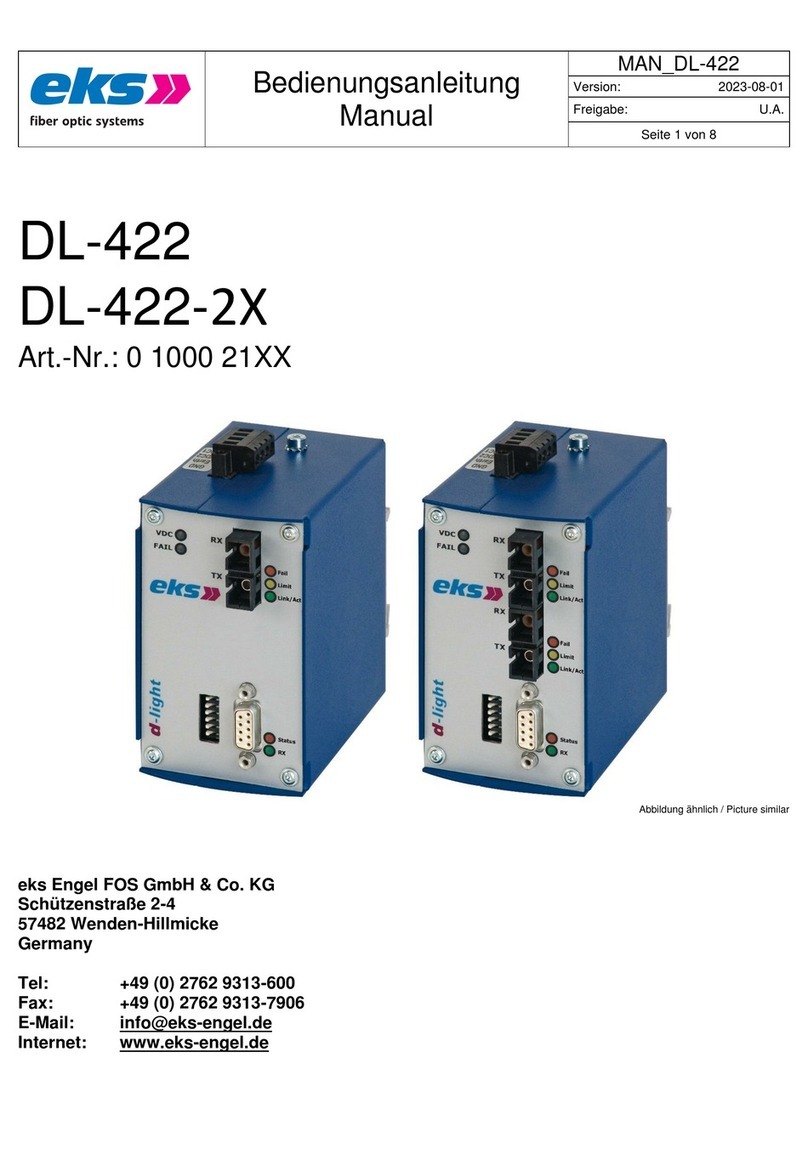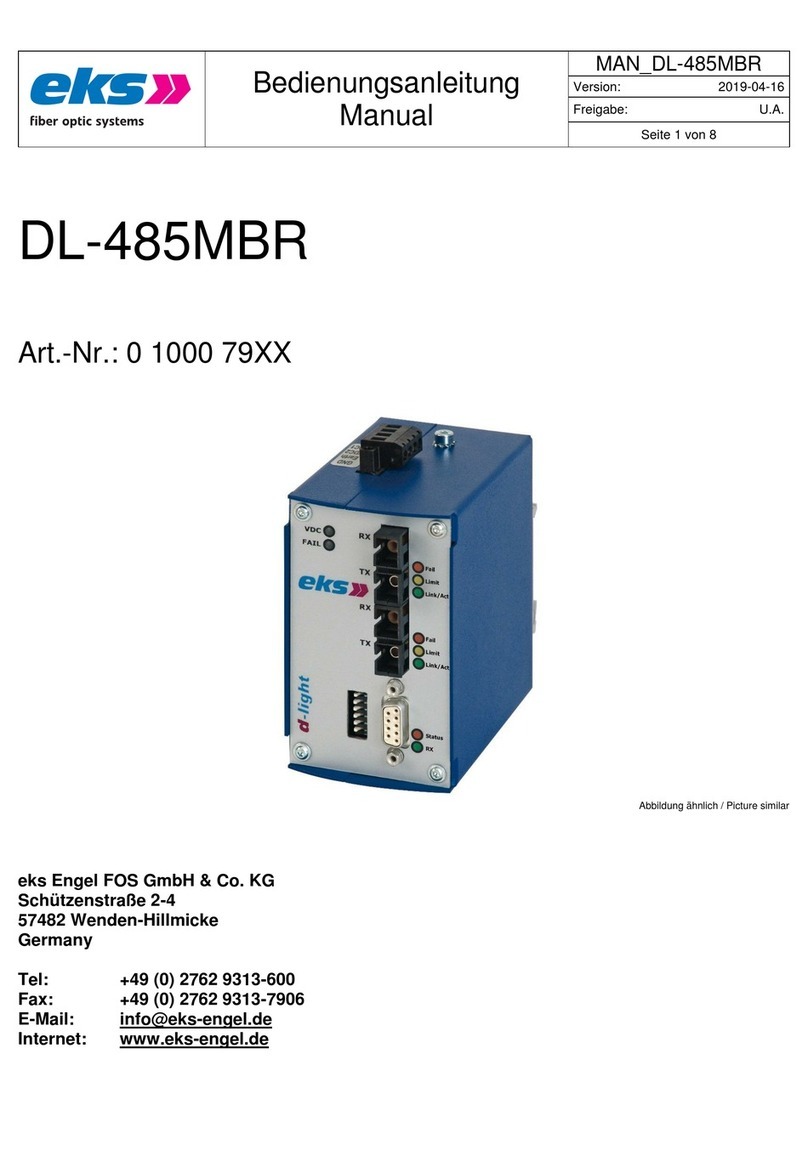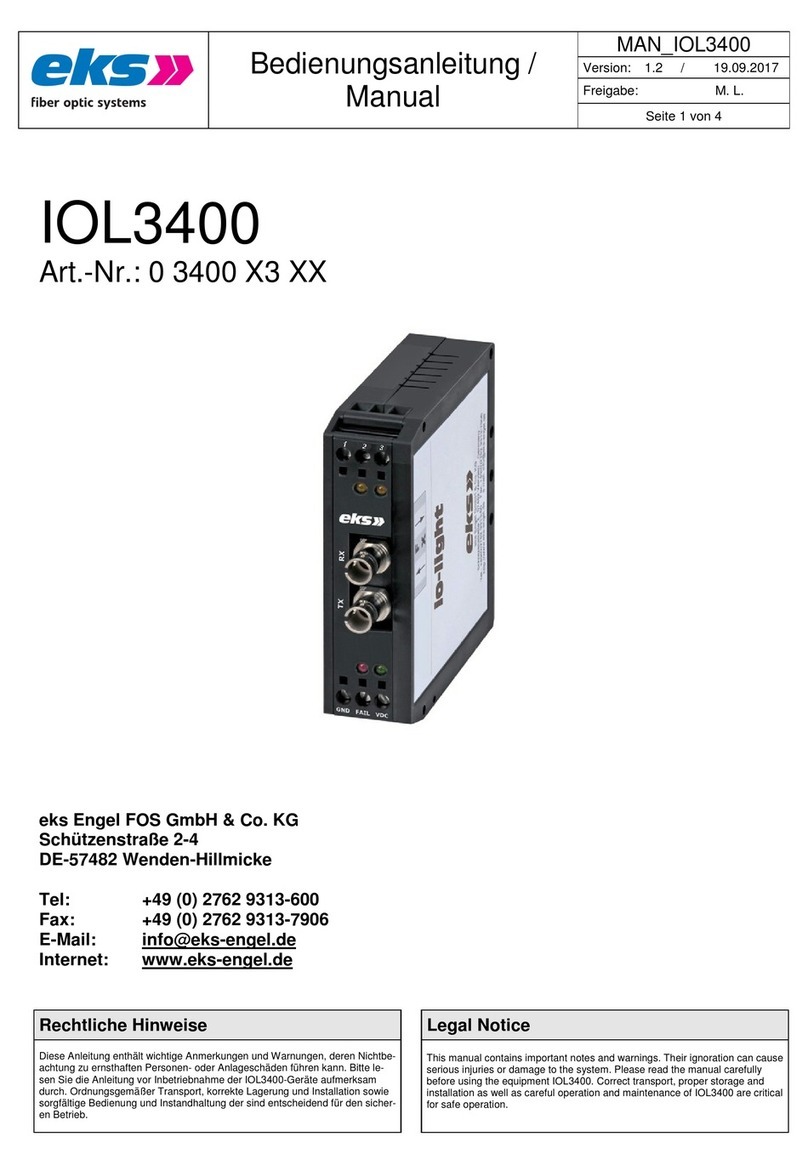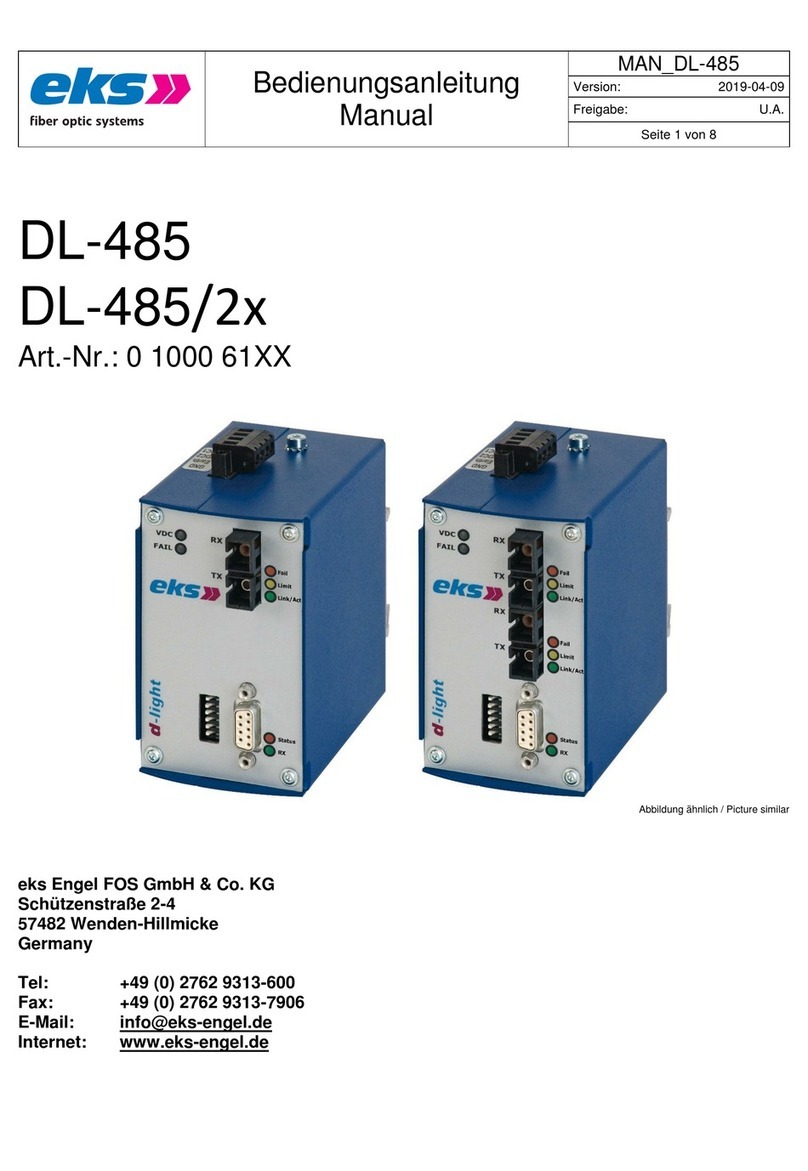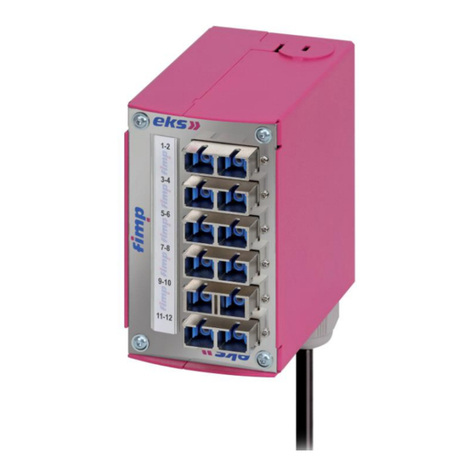
Bedienungsanleitung
Manual
Version: 3.8.4 / 18.09.2017
Freigabe: M. L.
Seite 2 von 4
Systembeschreibung System description
Die Geräte des Typs DL-485 dienen zur Verbindung von RS485-Segmenten
über Lichtwellenleiterstrecken. Sie besitzen zwei Versorgungsspannungsein-
gänge, so dass sie redundant mit Spannung versorgt werden können.
Die Datenraten bis 3 Mbit/s werden von den Systemen des Typs DL-485
protokolltransparent übertragen.
Als wichtige Leistungsmerkmale gelten die Übertragung mit Kunststofffaser-,
HCS, Multimode- oder Singlemode.
The interface modules DL-485 couples RS485 two-wire-segments via optical
fibres. They are equipped with two supply voltage input.
The data rates up to 3 Mbit/s are transmitted protocol transparent by the
DL-485.
Important performance features are the transmission via POF, HCS, multimode
or singlemode fiber optic.
Anschlusshinweise Hardware Installation
Achtung: Beim Betrieb elektrischer Betriebsmittel und Anlagen stehen zwangsläufig
bestimmte Teile unter gefährlicher Spannung. Arbeiten an elektrischen Anlagen
oder Betriebsmitteln dürfen nur von einer Elektrofachkraft oder von unterwiesenen
Personen unter Anleitung und Aufsicht einer Elektrofachkraft, den elektrotech-
nischen Regeln entsprechend, vorgenommen werden.
Schalten Sie die Systeme und Endgeräte spannungsfrei.
Rasten Sie das Gerät auf eine Tragschiene DIN EN auf, und überprüfen Sie den
sicheren Halt!
Achtung: Benutzen Sie nur die zugehörigen LWL-Anschlussstecker. Wir weisen
ausdrücklich daraufhin, dass der Anschluss mit falschen Steckverbinder Schäden
an den optischen Anschlüssen hervorrufen kann! Beachten Sie zudem, dass die
Stecker, die eine Verriegelung besitzen, nur in einer definierten Position montiert
werden können.
Achtung: Sehen Sie nicht in den optischen Sender! Das gebündelte und
abhängig von der Wellenlänge sichtbare oder unsichtbare Licht kann zu
Augenschäden führen!
Verbinden Sie den ankommenden Lichtwellenleiter mit dem optischen Empfänger
und den abgehenden LWL mit dem optischen Sender des LWL-System.
Benutzen Sie die beigefügten Stopfen, um Sender und Empfänger des LWL-
Systems im nicht eingebauten oder nicht benutzten Zustand vor Verunreinigungen
oder Staub zu schützen.
Achtung: Knicken Sie das LWL-Kabel nicht zu stark und beachten Sie den
Biegeradius des Kabelherstellers. Andernfalls kann das Kabel beschädigt werden
und/oder die Kommunikation zwischen den LWL-Wandlern nicht mehr
gewährleistet werden.
Schalten Sie die Betriebsspannung für die LWL-Systeme ein. Zur Versorgung der
Systeme wird eine Betriebsspannung von 12-30 VDC benötigt, die an die
Klemmen VDC1 oder VDC2 und GND angelegt wird. VDC1 und VDC2 sind
redundante Versorgungsspannungseingänge mit Verpolungsschutz.
Funktion des DIP-Switch :
SW1 bis SW3 : Abschlusswiderstand zwischen „D“ und „D/“
SW4 : nicht belegt
SW5 : nicht belegt
SW6 : nicht belegt
Funktion der Status-LEDs:
•VDC : Versorgungsspannung liegt an VDC1 oder VDC2 an
•FAIL : Sammel-Fehlermeldung und Fehlerrelais geöffnet
•Status : Empfangssignal fehlerhaft, (zu wenig Lichtleistung, anderes Signal
als erwartet)
•Rx : Empfang von Daten
Funktion der Status-LEDs Fiberview:
•Fail : Optisches Empfangssignal fehlerhaft
•Limit : Erreichen der Systemreserve
•Link/Act : Senden oder Empfang von Daten
Fehlerrelais: An den Klemmen K1 bis K3 befindet sich ein potentialfreier
Fehlerrelaiskontakt; K2 ist der gemeinsame Anschluss des Relais. Sobald die
optische Verbindung einwandfrei funktioniert zieht das Fehlerrelais an (K1-K2
geschlossen und K2-K3 geöffnet). Wird die optische Verbindung unterbrochen,
dann wird das Fehlerrelais geöffnet (K1-K2 geöffnet und K2-K3 geschlossen).
Ebenso öffnet das Fehlerrelais, wenn an keinem der beiden VDC-Eingänge eine
Versorgungsspannung anliegt.
Funktion der Kontakte K1 - K2: Fehlerrelaiskontakt: Öffnet im Fehlerfall
Funktion der Kontakte K2 – K3: Fehlerrelaiskontakt: Geschlossen im Fehlerfall
Achtung bei Systemen mit BIDI: Bei Verwendung von Systemen mit optischem
BIDI-Anschluss müssen immer die optischen Anschlüsse (Transceiver) vom Typ A
mit Typ B verbunden werden. Bei Systemen mit 2 FX-Ports ist der optische
Anschluss (Transceiver) mit dem Typ A immer der obere Anschluss.
POF-Verbindung:
Um das POF-Kabel mit dem Optolock zu verbinden, wird das Kabel zunächst sauber
abgeschnitten. Mit dem POF-Schneidwerkzeug wird das Kabel an der gewünschten
Stelle mit einem geraden Schnitt im 90°-Winkel getrennt. Die Enden der beiden
Fasern werden anschließend separiert. Jede Faser wird dann in eines der beiden
Löcher des Transceiver Gehäuses eingeführt und der Verschluss wird
zusammengepresst, um die POF-Faser in Position zu halten.
Beachten Sie bei der Verarbeitung von Lichtwellenleitern deren Biegeradius und den
Temperaturbereich der eingesetzten Stecker.
HINWEIS: Ein Dokument mit weiteren Hinweisen zur Verarbeitung von POF-Kabeln
und Transceivern finden Sie unter www.eks-engel.de/unternehmen/downloads/.
Power off the devices, which will be connected by using the fiber optic system.
Snap the system onto the DIN EN rail and check the correct holding!
Attention: Only use the correct optical connectors for the fiber optic system. Using
incorrect connectors can cause damage to the fiber optic system. Take care that
connectors with a latch can only be mounted in a defined position.
Attention: Don't stare into the optical cable or the transmitter of the fiber optic
system. Visible and non visible light (depending on its wavelength) of the optical
transmitter can cause eye-damages!
Connect the fiber optic system by using the correct fiber optic cable. Take care that
you always have to connect an optical transmitter with an optical receiver.
Use the plugs to save the unused optical receiver and transmitter against impurity.
Attention: Don't bend the fiber optic cable! Please refer to the manufacturer’s
specification. Otherwise the fiber optic cable can be damaged or the
communication is disturbed.
Power on the devices. Please use a power supply of 12-30 VDC, connected to the
terminals marked with VDC1, VDC 2 and GND. Note, that VDC 1 and VDC 2 are
redundant power inputs with reverse voltage protection.
Function of the DIP-Switch :
SW1 to SW3 : termination between “D” and “D/”
SW4 : without any function
SW5 : without any function
SW6 : without any function
Function of the Status-LEDs:
•VDC : Power Supply at VDC1 or VDC2
•FAIL : Failure group signal and failure relay opened
•Status : Received signal failed, (too little light output, signal other than
expected)
•Rx : Data being received.
Function of the Status-LEDs Fiberview:
•Fail : Received optical signal failed
•Limit : System reserve reached
•Link / Act : Transmitting or receiving data
Failure Relay: Terminals K1 to K3 are connected to a potential free relay. If the
optical connection works without failures the relay gets active and closes K1 to K2
and opens K2 to K3. If the optical connection is disconnected or power supply at
VDC1 or VDC2 fails, the relay will get inactive and K1 to K2 opens and K2 to K3
closes
Function of K1 – K2: Potential free failure relay contact NC.
Function of K2 –K3: Potential free failure relay contact NO.
Attention: Systems with BIDI transceivers always have to be connected from
transceiver type A to a transceiver type B. Switches with 2 FX-Ports always have
transceiver type A as the upper one.
POF-connection:
To connect the POF cable into the Optolock, the end of the cable is cut cleanly. Use
a POF-Cutter to make a straight cut in an angle of 90° at the chose position of the
cable. After that the end of the two strands are separated. Then the strands are
inserted into the two holes in the termination housing, which is then pressed close to
hold the POF in place.
Pay attention on the bending radius of the optical cables while installing them and
check the temperature range of the used plugs.
PLEASE NOTE: You can find a document with remarks concerning the handling of
POF-Cable and Transceiver on www.eks-engel.de/unternehmen/downloads/.






